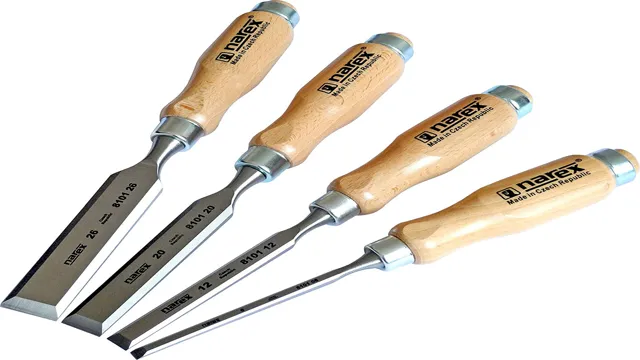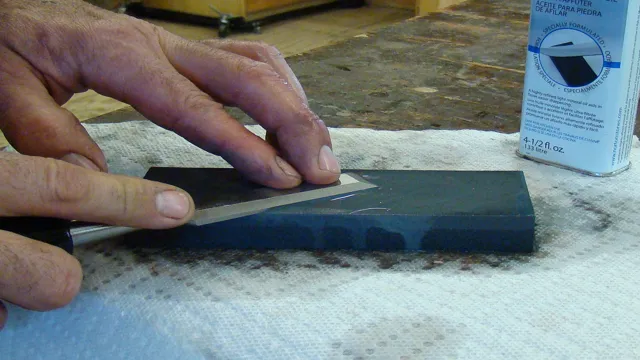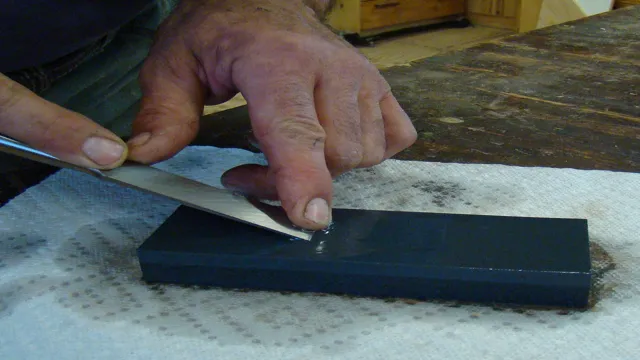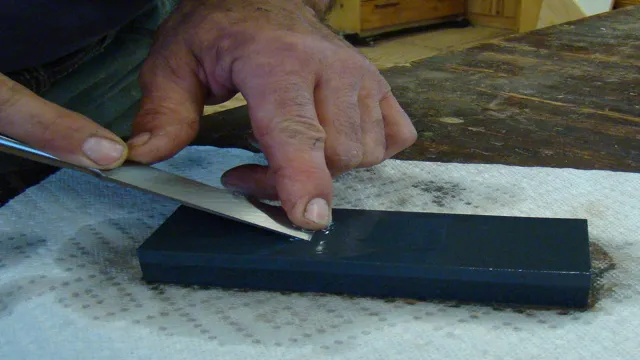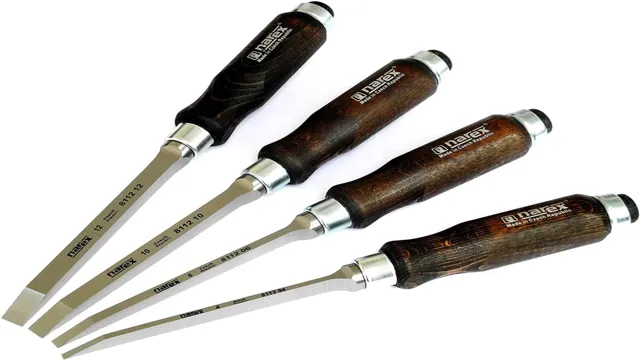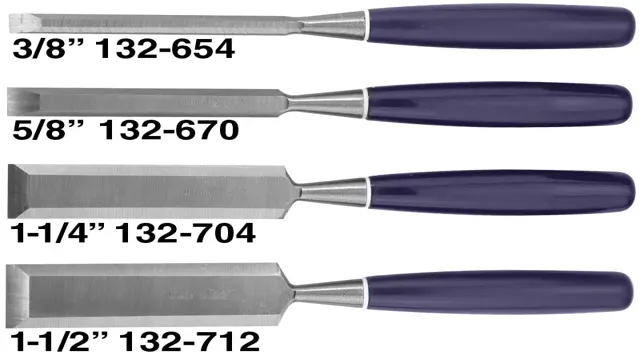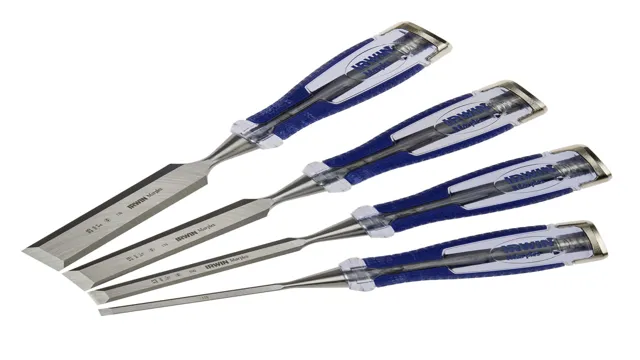How to Use Wood Turning Chisels: A Comprehensive Guide for Beginners
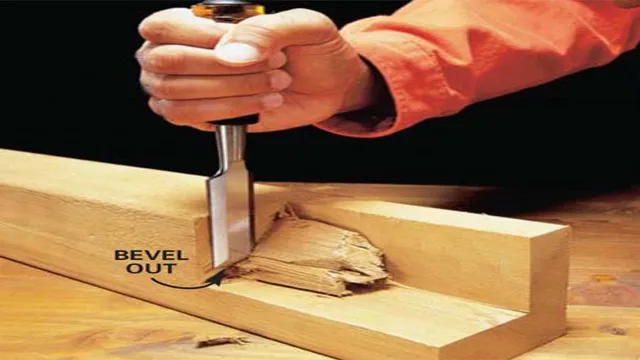
Are you a woodworking enthusiast looking to take your craft to the next level? Wood turning chisels are an essential tool in woodturning and can help you achieve beautifully crafted pieces. Understanding how to use these chisels is crucial to ensure safety and precision during the woodturning process. In this beginner’s guide, we’ll cover the basics of wood turning chisels.
From the different types of chisels and their uses, to how to properly hold and handle them, we’ll provide you with all the information you need to begin your woodturning journey with confidence. Whether you’re interested in creating intricate designs or simple shapes, woodturning can be a fulfilling and rewarding hobby. And with the right tools, you can bring your visions to life.
So, let’s delve into the world of wood turning chisels and discover all the wonders they can bring to your woodworking creations.
What are wood turning chisels?
Wood turning chisels are essential tools for any woodturner, whether you are a beginner or an expert. These chisels come in different sizes and shapes, each tailored for specific cuts, and they are used to shape and carve wood pieces into a variety of decorative items. Knowing how to use wood turning chisels is crucial in achieving a successful project.
First, you need to identify the type of chisel you need for your project. Then, hold the tool firmly and make sure it is sharp. Start by making shallow cuts and gradually work your way deeper into the wood.
Keep your movements steady and smooth, letting the cutting edge do the work. Practice different techniques, such as peeling, slicing, and digging to achieve different effects. Remember to always wear protective gear and practice safety measures when handling wood turning chisels.
With time and experience, you can perfect your skills and create beautiful pieces of art with these versatile tools.
Description and Types of Wood Turning Chisels
Wood turning chisels are tools designed specifically for the task of turning wood. These chisels come in a variety of shapes and sizes and are primarily used for removing wood from a turning workpiece to create the desired shape. The three main types of wood turning chisels are gouges, scrapers, and parting tools.
Gouges are curved chisels with sharpened edges used for creating concave shapes. Scrapers, on the other hand, have a flat surface that is used to smooth out surfaces and remove rough areas. Parting tools are straight chisels used to cut grooves and separate pieces.
Each of these chisels is highly specialized and has a specific use in the wood turning process. Knowing the different types and how to use them properly can greatly improve the outcome of any wood turning project.

Understanding the Parts of a Wood Turning Chisel
Wood turning chisels are essential tools for woodturners who create beautiful, functional objects from raw wood. These chisels are used to shape, carve, and cut wood on a lathe to create a variety of objects such as bowls, vases, and furniture legs. The chisels are made up of three parts, the handle, the shank, and the blade.
The handle is where the wood turner grips the tool while working. It’s made of various materials such as wood, plastic, or rubber to make it easy to hold and minimize vibration. The shank is the middle part of the tool that connects the handle to the blade.
It’s usually made of high-quality steel to provide strength and durability. The blade is the cutting edge of the tool and is made of high-speed steel for long-lasting sharpness. The blade’s shape and size determine its suitability for different cutting tasks, such as roughing gouges for removing large amounts of material or spindle gouges for fine detailing.
Understanding the difference between the various parts of a wood turning chisel is essential to ensure that you use the right tool for the job and create a beautiful piece of turned wood.
Preparing the Workspace and Material
When it comes to using wood turning chisels, preparation is key. Before starting any wood turning project, it is important to ensure your workspace is clean and free of clutter. This not only allows for easier movement when using the chisels, but also reduces the risk of injury.
Additionally, you will want to make sure you have the appropriate safety gear, such as safety glasses and a dust mask to protect your eyes and lungs from sawdust and debris. Once your workspace is set up, you’ll want to select the appropriate chisels for your project. Different chisels are designed for different cuts, such as roughing, detailing, and finishing, so it’s important to have a variety on hand.
After selecting your chisels, it’s time to prepare your wood. Make sure it is properly sized and secured in your lathe. It’s also a good idea to mark guidelines on the wood to help guide your cuts.
With a clean workspace, appropriate safety gear, the right tools, and properly prepared wood, you’re ready to start using your wood turning chisels and bring your woodworking project to life.
Selecting the Right Workpiece
When preparing your workspace and material for your next woodworking project, it’s important to select the right workpiece. You want to choose a piece of wood that is both high-quality and appropriate for the project at hand. Look for wood that has a straight grain and minimal knots, as this will ensure a smoother and more durable finished product.
It’s also important to consider the size of the workpiece in relation to your workspace and tools. Make sure you have enough space to comfortably work on the wood and that your tools are capable of handling the size. Additionally, be mindful of the species of wood you choose, as different types have varying characteristics that can affect the final outcome of your project.
By taking the time to carefully select your workpiece, you can increase your chances of success and create a finished product that you’re proud of.
Choosing the Best Lathe and Accessories
When it comes to preparing your workspace and materials for your lathe, there are a few key things to keep in mind. First, you’ll want to make sure that you have a dedicated space for your lathe that is well-ventilated and free from clutter. This will help you work safely and efficiently, without any distractions or obstacles getting in the way.
You’ll also want to gather all of the materials and tools that you’ll need, including your lathe accessories, cutting tools, and measuring instruments. Make sure that your materials are clean and free from defects, and that you have enough of everything to complete your project without running out. With these tips in mind, you’ll be well on your way to a successful lathe project that you can be proud of.
Basic Techniques for Using Wood Turning Chisels
Learning how to use wood turning chisels can seem daunting at first, but with a bit of practice, you can easily master this essential skill. One of the most important techniques to keep in mind is to hold your chisel correctly. Make sure to grip the handle firmly with your dominant hand and rest your other hand on the tool rest for added stability.
Another important technique is to always cut downhill in the direction of the grain to prevent tear-out and splintering. When holding the chisel against the wood, apply gentle pressure and twist the tool slightly to create a smooth cut. It’s also important to keep your tools sharp, as dull chisels can be dangerous to work with and won’t produce clean cuts.
By keeping these tips in mind and practicing regularly, you’ll soon be able to create beautiful turned wood pieces with ease.
Holding the Chisel Correctly
One of the fundamental skills you need to learn when working with wood turning chisels is how to hold them correctly. Holding the chisel correctly provides you with more control over the tool and helps prevent any mishaps. To do this, you should always hold the chisel firmly but comfortably, with your index finger and thumb gripping the handle and your remaining fingers supporting the tool’s shank.
It’s also essential to keep the chisel steady, so you should avoid gripping it too tightly or too loosely. Finding the right balance takes time and practice, but once you get the hang of it, you’ll be able to create smoother and more detailed cuts on your wood creations.
Making the First Cut
Wood turning chisels are essential tools for any woodworker. Learning to use them properly is key to ensuring that your projects turn out just the way you want. When making the first cut, it’s important to keep a few things in mind.
First, make sure that your chisel is sharp and in good condition. Dull tools will only lead to frustration and wasted effort. Secondly, always make sure that your workpiece is firmly secured to the lathe.
You don’t want it to move or shift and cause an accident. Once you’re ready to make your cut, place the chisel on the wood and apply pressure using your body weight. Keep your other hand firmly on the handle to guide the tool.
With a little practice, you’ll be able to create smooth, even cuts and turn out beautiful pieces every time.
Creating Shapes and Designs with Chisels
Wood turning chisels are essential tools for creating unique and intricate designs on wooden surfaces. However, mastering the basic techniques of using these chisels requires patience and practice. One important technique is the use of the “bevel rubbing” method, where the chisel’s sharp edge is angled towards the wood surface and rubbed against it.
This ensures smooth and precise cuts while avoiding any accidental slip-ups that could damage the wood. Another essential technique is to keep the chisel sharp at all times, which can be achieved by regular honing or using a sharpening stone. It’s also important to match the chisel’s shape to the design you want to create.
For instance, a gouge chisel is ideal for creating curves, while a square-end chisel is perfect for creating flat surfaces. By mastering these basic techniques, you’ll be able to create unique and beautiful designs on your wooden surfaces that are sure to impress.
Maintenance and Safety Tips for Wood Turning Chisels
If you’re just starting out with wood turning, learning how to use wood turning chisels is an important first step. However, it’s just as important to know how to maintain and use them safely. Regular maintenance can help extend the life of your chisels, while proper use can prevent accidents and injury.
Some tips for maintaining your wood turning chisels include keeping them sharp, cleaning them after each use, and storing them in a dry place. When it comes to safety, always wear protective gear like safety glasses and a dust mask, and be mindful of how you position your body and hands while using the chisels. With these tips in mind, you can enjoy the art of wood turning while keeping yourself safe and your chisels in top condition.
Conclusion
In conclusion, using wood turning chisels is like being a sculptor with wood as their medium. With the right chisel in hand and a sharp edge, you can transform a block of wood into a beautiful work of art. It’s important to choose the right chisel for the task at hand, whether it’s a roughing gouge for removing material quickly or a skew chisel for precise details.
And remember, practice and patience are key. Don’t be afraid to make mistakes and experiment with different techniques. Who knows, you may just find your inner Michelangelo in the process!”
FAQs
What are wood turning chisels used for?
Wood turning chisels are used for shaping and carving wood on a lathe machine.
How many types of wood turning chisels are there?
There are six main types of wood turning chisels: spindle gouge, bowl gouge, roughing gouge, parting tool, skew chisel, and scraper.
What is the difference between a spindle gouge and a bowl gouge?
The spindle gouge is used for making fine cuts on smaller pieces of wood on the lathe, while the bowl gouge is used for roughing out larger pieces of wood.
How do you sharpen wood turning chisels?
Wood turning chisels are typically sharpened using a grinder or a sharpening stone. It’s important to maintain a consistent angle while sharpening and to sharpen both sides of the chisel evenly.
Can you use wood turning chisels on other materials besides wood?
It’s not recommended to use wood turning chisels on other materials besides wood, as they are designed specifically for woodwork and can chip or break if used on other materials.
Are there any safety precautions to take when using wood turning chisels?
Yes, it’s important to wear proper safety gear such as eye protection and gloves when using wood turning chisels. It’s also important to keep your work area clean and organized and to keep your hands away from the cutting edge of the chisels.
Can beginners use wood turning chisels?
Yes, beginners can use wood turning chisels, but it’s important to start with basic techniques and to take proper safety precautions. It’s also helpful to take classes or watch tutorials to learn proper techniques and safety guidelines.

